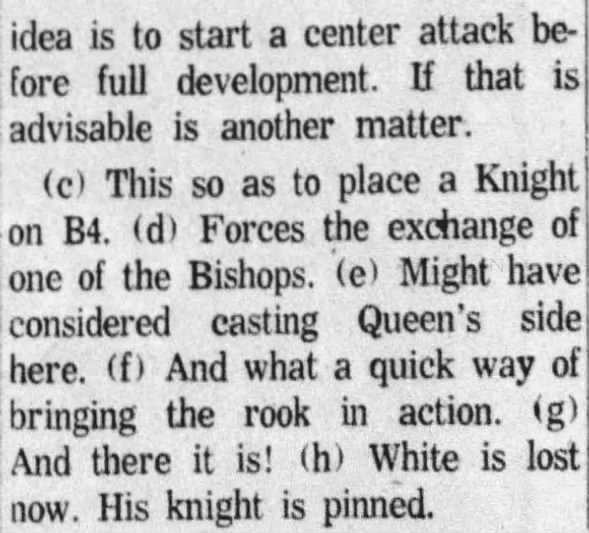
 Chess Chats 18 Oct 1959, Sun The Press Democrat (Santa Rosa, California) Newspapers.com
Chess Chats 18 Oct 1959, Sun The Press Democrat (Santa Rosa, California) Newspapers.com
Chess Chats by George Koltanowski
International Chess Master
If anyone asked why one chess army was black and the opposing army white, you would probably think it was a pretty silly question. But is it?
In the late 18th century a Chinese set appeared in which all the pieces looked like Chinese soldiers, mandarins and the like, but all had the faces of rats!
Both sides were in white ivory and, although each side was slightly different in design, the only really distinctive difference between the two sides were the eyes of the rats, for one side had ruby eyes and the other had amber eyes.
But it was not the eyes that made it simple for the opponent to distinguish their men: it was the simple fact that one side faced one way and the other side the other way.
In other words, only in sets in which the pieces are symbols, facing all ways at one time, are the two colors really necessary.
This brings me to the suggestion, why not design a “penguin” chess set! Both sides could be exactly the same but there would rarely be any confusion because a player would always see the black side of his own penguins and the white sides of his opponents!
Played in Barcelona tournament Nov. 27, 1934.
J. Ribera, champion of Catalonia (white) vs. George Koltanowski (black)
King's Indian Defense: Sämisch Variation
(a) The Samisch line considered one of the strongest lines for White against the King's Indian.
(b) A new idea, which morally upset my opponent immensely … he had never seen this line before. Black's idea is to start a center attack before full development. If that is advisable is another matter.
(c) This so as to place a Knight on B4.
(d) Forces the exchange of one of the Bishops.
(e) Might have considered casting Queen's side here.
(f) And what a quick way of bringing the rook in action.
(g) And there it is!
(h) White is lost now. His knight is pinned.






















